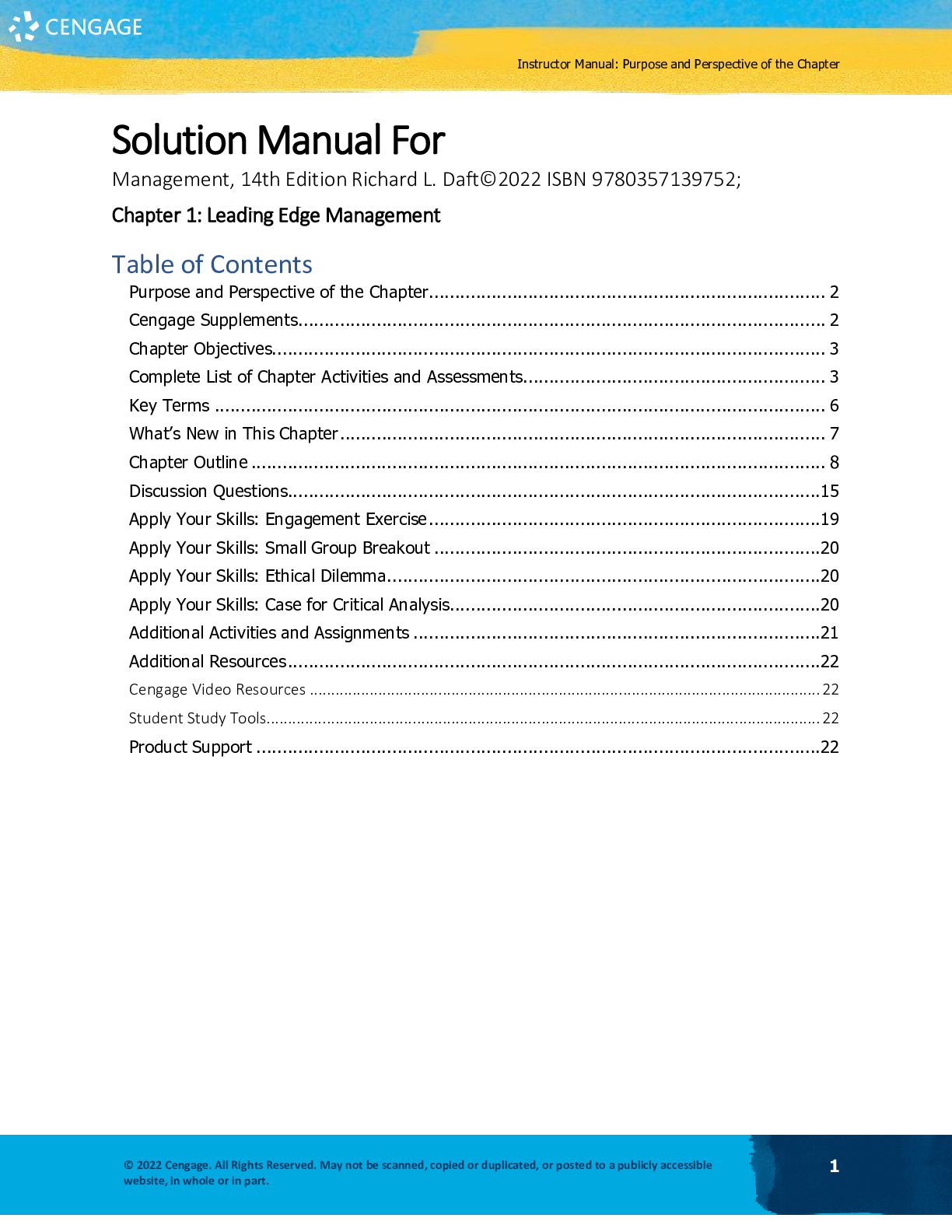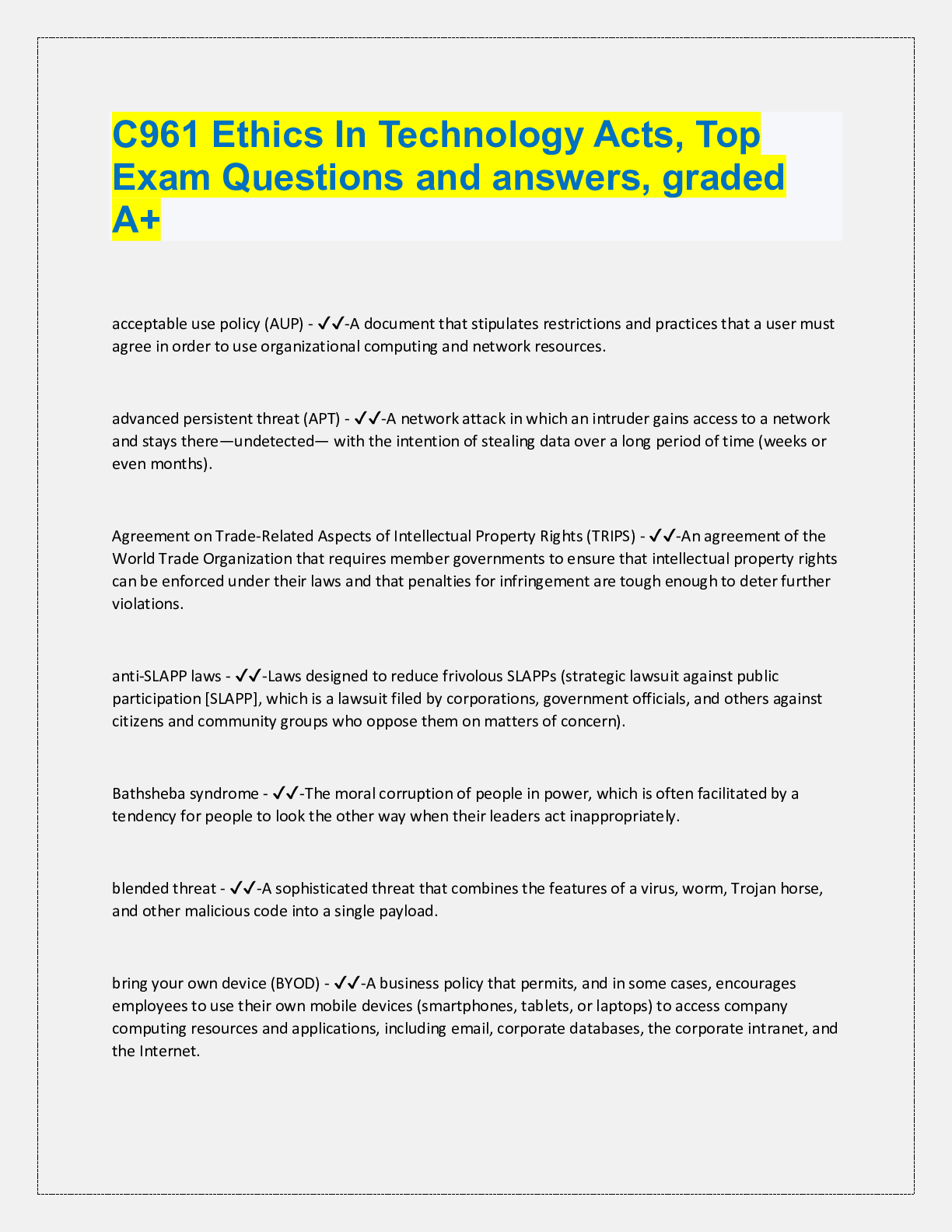
Management, 14th Edition by Richard Daft. All Chapter 1-19 | Solution Manual
Ethics and Computer Science > QUESTIONS & ANSWERS > C961 Ethics In Technology Acts, Top Exam Questions and answers, graded A+ (All)
C961 Ethics In Technology Acts, Top Exam Questions and answers, graded A+ acceptable use policy (AUP) - ✔✔-A document that stipulates restrictions and practices that a user must agree in or ... der to use organizational computing and network resources. advanced persistent threat (APT) - ✔✔-A network attack in which an intruder gains access to a network and stays there—undetected— with the intention of stealing data over a long period of time (weeks or even months). Agreement on Trade-Related Aspects of Intellectual Property Rights (TRIPS) - ✔✔-An agreement of the World Trade Organization that requires member governments to ensure that intellectual property rights can be enforced under their laws and that penalties for infringement are tough enough to deter further violations. anti-SLAPP laws - ✔✔-Laws designed to reduce frivolous SLAPPs (strategic lawsuit against public participation [SLAPP], which is a lawsuit filed by corporations, government officials, and others against citizens and community groups who oppose them on matters of concern). Bathsheba syndrome - ✔✔-The moral corruption of people in power, which is often facilitated by a tendency for people to look the other way when their leaders act inappropriately. blended threat - ✔✔-A sophisticated threat that combines the features of a virus, worm, Trojan horse, and other malicious code into a single payload. bring your own device (BYOD) - ✔✔-A business policy that permits, and in some cases, encourages employees to use their own mobile devices (smartphones, tablets, or laptops) to access company computing resources and applications, including email, corporate databases, the corporate intranet, and the Internet. BSA | The Software Alliance (BSA) - ✔✔-A trade group that represent the world's largest software and hardware manufacturers. CAPTCHA (Completely Automated Public Turing Test to Tell Computers and Humans Apart) - ✔✔- Software that generates and grades tests that humans can pass and all but the most sophisticated computer programs cannot. Child Online Protection Act (COPA) - ✔✔-An act signed into law in 1998 with the aim of prohibiting the making of harmful material available to minors via the internet; the law was ultimately ruled largely unconstitutional. Children's Internet Protection Act (CIPA) - ✔✔-An act passed in 2000; it required federally financed schools and libraries to use some form of technological protection (such as an internet filter) to block computer access to obscene material, pornography, and anything else considered harmful to minors. CIA security triad - ✔✔-Refers to confidentiality, integrity, and availability. clinical decision support (CDS) - ✔✔-A process and a set of tools designed to enhance healthcare-related decision making through the use of clinical knowledge and patient-specific information to improve healthcare delivery. Communications Decency Act (CDA) - ✔✔-Title V of the Telecommunications Act, it aimed at protecting children from pornography, including imposing $250,000 fines and prison terms of up to two years for the transmission of "indecent" material over the internet. computerized provider order entry (CPOE) system - ✔✔-A system that enables physicians to place orders (for drugs, laboratory tests, radiology, physical therapy) electronically, with the orders transmitted directly to the recipient. Controlling the Assault of Non-Solicited Pornography and Marketing (CAN-SPAM) - ✔✔-A law that specifies that it is legal to spam, provided the messages meet a few basic requirements—spammers cannot disguise their identity by using a false return address, the email must include a label specifying that it is an ad or a solicitation, and the email must include a way for recipients to indicate that they do not want future mass mailings. Controlling the Assault of Non-Solicited Pornography and Marketing (CAN-SPAM) Act - ✔✔-A law that specifies that it is legal to spam, provided the messages meet a few basic requirements spammers cannot disguise their identity by using a false return address, the email must include a label specifying that it is an ad or a solicitation, and the email must include a way for recipients to indicate that they do not want future mass mailings. corporate social responsibility (CSR) - ✔✔-The concept that an organization should act ethically by taking responsibility for the impact of its actions on its shareholders, consumers, employees, community, environment, and suppliers. Defend Trade Secrets Act of 2016 - ✔✔-An act passed in 2016 that amended the Economic Espionage Act to create a federal civil remedy for trade secret misappropriation. Department of Homeland Security (DHS) - ✔✔-A large federal agency with more than 240,000 employees and a budget of almost $65 billion whose goal is to provide for a "safer, more secure America, which is resilient against terrorism and other potential threats." Digital Millennium Copyright Act (DMCA) - ✔✔-Signed into law in 1998, the act addresses a number of copyright-related issues, with Title II of the act providing limitations on the liability of an Internet service provider for copyright infringement. distributed denial-of-service (DDoS) attack - ✔✔-An attack in which a malicious hacker takes over computers via the Internet and causes them to flood a target site with demands for data and other small tasks. Economic Espionage Act (EEA) of 1996 - ✔✔-An act passed in 1996 to help law enforcement agencies pursue economic espionage. It imposes penalties of up to $10 million and 15 years in prison for the theft of trade secrets. Electronic Product Environmental Assessment Tool (EPEAT) - ✔✔-A system that enables purchasers to evaluate, compare, and select electronic products based on a total of 51 environmental criteria. fair use doctrine - ✔✔-A legal doctrine that allows portions of copyrighted materials to be used without permission under certain circumstances. Title 17, section 107, of the U.S. Code established the following four factors that courts should consider when deciding whether a particular use of copyrighted property is fair and can be allowed without penalty: 1) the purpose and character of the use (such as commercial use or nonprofit, educational purposes), 2) the nature of the copyrighted work, 3) the portion of the copyrighted work used in r [Show More]
Last updated: 2 years ago
Preview 1 out of 6 pages

Buy this document to get the full access instantly
Instant Download Access after purchase
Buy NowInstant download
We Accept:


WGU C961 - ALL Section Quizzes, Questions and answers, graded A+
By Topmark 2 years ago
$29
18
Can't find what you want? Try our AI powered Search
Connected school, study & course
About the document
Uploaded On
Mar 14, 2023
Number of pages
6
Written in
All
This document has been written for:
Uploaded
Mar 14, 2023
Downloads
0
Views
146
Scholarfriends.com Online Platform by Browsegrades Inc. 651N South Broad St, Middletown DE. United States.
We're available through e-mail, Twitter, Facebook, and live chat.
FAQ
Questions? Leave a message!
Copyright © Scholarfriends · High quality services·